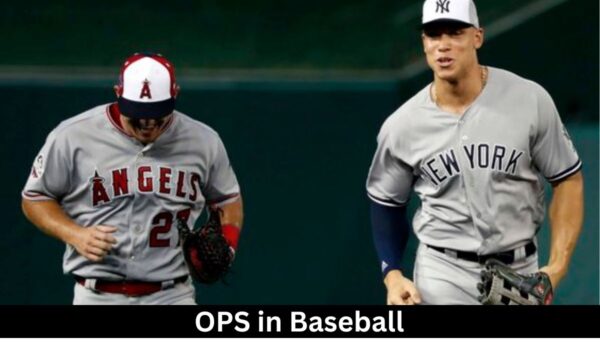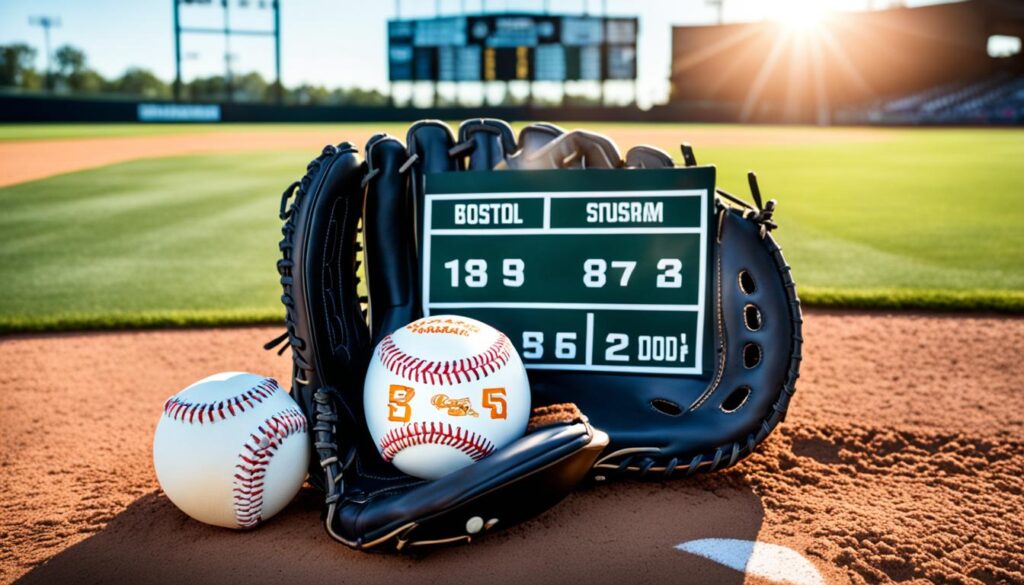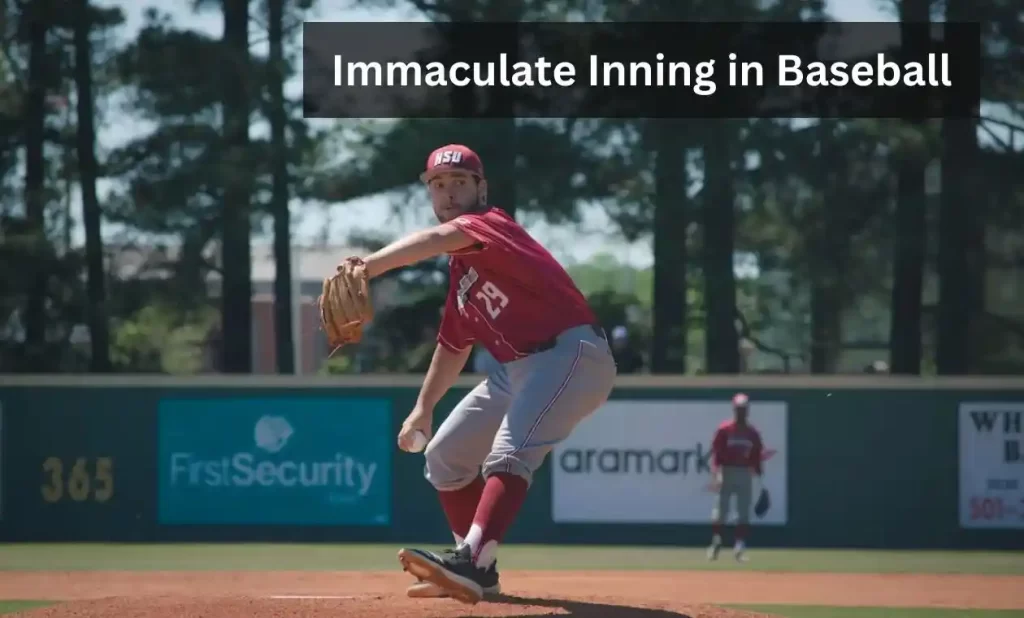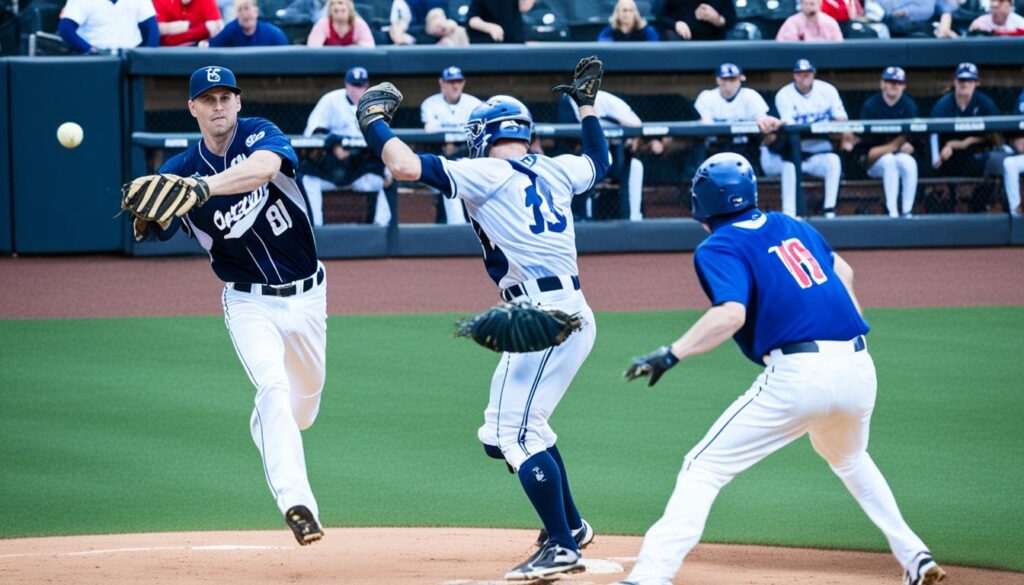
Have you ever wondered what makes a baseball player truly outstanding? Is it their batting average, their ability to get on base, or their power hitting? Well, there’s a statistic that combines all of these factors and provides a comprehensive assessment of a player’s offensive performance. It’s called OPS – On-base Plus Slugging.
OPS has been around for over a century and has become increasingly popular among teams and scouts as a quick way to compare players across different positions. But what exactly is a good OPS in baseball? How is it calculated? And who are the players with the highest OPS in history? Let’s dive into the key metrics of OPS and uncover the secrets behind this fascinating statistic.
Key Takeaways:
- OPS combines a player’s on-base percentage (OBP) and slugging percentage (SLG).
- A good OPS indicates a player’s effectiveness at getting on base and hitting for extra bases.
- The formula for OPS is OBP + SLG.
- An OPS above .800 is generally considered good, with a 1.000 OPS seen as outstanding.
- OPS leaders in baseball history include players like Alex Rodriguez, Bryce Harper, David Ortiz, and David Davis.
What is OPS in Baseball?
OPS, which stands for On-base Plus Slugging, is a sabermetric statistic used to measure a player’s offensive performance in baseball. It combines a player’s on-base percentage (OBP) and slugging percentage (SLG) by adding them together. OBP measures how often a player reaches base safely, while SLG measures their ability to hit for extra bases. The formula for OPS is OBP + SLG. This statistic provides a more comprehensive assessment of a player’s offensive output beyond basic stats like batting average, taking into account plate appearances, walks, strikeouts, and other key factors.
Understanding OPS in baseball is crucial for evaluating a player’s offensive impact. It reveals their ability to get on base and hit for power, giving teams a valuable tool for assessing overall performance. OPS allows for a fair comparison of players from different positions, providing a holistic view of their offensive contributions.
How to Calculate OPS in Baseball
Calculating OPS in baseball is relatively straightforward. To calculate OPS, you take a player’s on-base percentage (OBP) and slugging percentage (SLG), then add them together.
To calculate OBP, divide the player’s total number of times reaching base (hits, walks, hit by pitch) by their total number of plate appearances.
To calculate SLG, add up the player’s total bases (singles, doubles, triples, home runs) and divide that by their total number of at-bats.
Once you have these two percentages, simply add them together to get the player’s OPS.

“Calculating OPS in baseball is like combining the best of both worlds. By taking the player’s on-base percentage and slugging percentage into account, you get a more complete picture of their offensive capabilities.”
What is a Good OPS in Baseball?
The average OPS in Major League Baseball can vary from year to year, but it typically falls around.750. However, the definition of a good OPS depends on the context. In general, an OPS above.800 indicates a good-to-very-good hitter. On the other hand, a 1.000 OPS is considered outstanding and is often seen as a benchmark for elite offensive players. It is crucial to note that OPS can vary by position, as the expectations for offensive production differ among different positions on the field.
If we look at the numbers, an OPS of.800 or above shows that a player has a strong ability to both reach base and hit for power. These players have a higher chance of contributing positively to their team’s offense and creating scoring opportunities. Conversely, a lower OPS may suggest that a player needs to improve their offensive performance in order to be considered a reliable offensive contributor.

OPS has become an increasingly valuable statistic in baseball as teams and scouts recognize its significance in evaluating offensive prowess. By considering a player’s OPS, teams can make informed decisions about player acquisitions, lineup placements, and overall offensive strategy. It provides a more comprehensive assessment of a player’s offensive abilities than traditional stats like batting average alone.
OPS goes beyond individual stats like batting average by incorporating a player’s ability to reach base and hit for power, making it a valuable metric for evaluating offensive performance in baseball.
Moreover, OPS allows for easy player comparisons across different positions and eras, helping to identify exceptional offensive talents. It has become a useful tool for baseball analysts and fans alike to appreciate the skill and impact of players who excel at getting on base and hitting for extra bases.
Ultimately, a good OPS in baseball indicates a player’s ability to contribute significantly to their team’s offense. It showcases their effectiveness in both reaching base and providing extra-base hits. While the average OPS can vary, an OPS above.800 is generally considered good and highlights a player’s offensive capabilities.
Who has the Highest OPS in Baseball?
Throughout baseball history, there have been several players known for having the highest OPS. Some notable players with impressive OPS numbers include Alex Rodriguez, Bryce Harper, David Ortiz, and David Davis. These players consistently hit for high averages and displayed powerful hitting abilities, making them stand out as some of the best hitters in baseball history.
“I have always admired the remarkable OPS numbers of these players. They have truly left a mark on the game with their exceptional offensive production.” – Baseball Enthusiast
OPS leaders can vary by season and era, but these players are consistently recognized for their exceptional offensive production. Whether it’s the ability to get on base or hit for extra bases, these players have demonstrated their prowess at the plate.
The Impressive Offensive Performances of OPS Leaders
- Alex Rodriguez: Known for his power-hitting and ability to drive in runs, Rodriguez consistently posted impressive OPS numbers throughout his career.
- Bryce Harper: With his combination of power and a keen eye at the plate, Harper has consistently been among the OPS leaders in recent years.
- David Ortiz: The legendary designated hitter, Ortiz, was a force to be reckoned with at the plate, consistently putting up impressive OPS numbers.
- David Davis: Davis made a name for himself with his exceptional power-hitting and consistently high OPS numbers.
These players serve as examples of the remarkable offensive talents that can be seen in the game of baseball. They have left a lasting legacy and continue to inspire future generations of players.
Is a 700 OPS Good?
According to baseball experts, a 700 OPS puts a player in the top third of all hitters in Major League Baseball and is considered above average. While not elite, a 700 OPS is still a respectable achievement and can contribute to a team’s offensive success. It’s important to consider other factors in conjunction with OPS, such as a player’s defensive abilities and overall contribution to the team, to fully evaluate their impact on the game.
Understanding OPS in Baseball
In order to comprehend the significance of a 700 OPS, it’s essential to have a clear understanding of OPS in baseball. OPS, which stands for “On-base Plus Slugging,” is a statistic used to measure a player’s offensive performance. It combines a player’s on-base percentage (OBP) and slugging percentage (SLG) to provide a comprehensive assessment of their ability to reach base and hit for power.
“A good OPS indicates a player’s effectiveness at getting on base and hitting for extra bases.”
OPS has been used since the early 20th century and has gained popularity among teams and scouts as a quick metric to compare players across different positions. It goes beyond basic stats like batting average and takes into account a player’s plate appearances, walks, strikeouts, and other key factors to provide a more comprehensive evaluation of their offensive output.
While a 700 OPS is not considered elite, it still represents above average performance in the realm of hitting. It reflects a player’s ability to get on base and hit for power, contributing positively to their team’s offensive success. However, it’s important to remember that OPS should not be viewed in isolation. Considering a player’s overall contributions, including their defensive abilities and team dynamics, provides a well-rounded assessment of their impact on the game.
Factors Influencing OPS
Although a 700 OPS is a commendable achievement, it’s necessary to consider the various factors that can influence this statistic. Players’ OPS can vary depending on their position, as expectations for offensive production differ among different positions on the field. For example, a shortstop with a 700 OPS may be considered outstanding due to their defensive skills, while a first baseman with the same OPS may be seen as below average due to the position’s offensive expectations.
- Plate appearances: The number of times a player comes to the plate affects their chances of reaching base and hitting for power. A higher number of plate appearances provides more opportunities for a player to improve their OPS.
- Quality of opposition: The level of competition faced by a player can impact their OPS. Facing stronger pitchers or defenses may result in a lower OPS, while facing weaker opponents can lead to a higher OPS.
- Park factors: The dimensions and characteristics of the stadium in which a player performs can influence their OPS. Ballparks with shorter fences or favorable hitting conditions can boost a player’s OPS, while larger or more pitcher-friendly parks may suppress it.
In conclusion, while a 700 OPS may not be considered elite, it is still indicative of above-average offensive performance in baseball. Understanding the context in which a player achieves their OPS is crucial, as factors such as position, plate appearances, quality of opposition, and park factors can all impact this statistic. By considering OPS in conjunction with other factors, teams and scouts can make more informed evaluations of a player’s offensive contributions and overall impact on the game.
Do Walks Count for OPS?
Yes, walks do count for OPS. In fact, walks are an important component of a player’s on-base percentage (OBP), which is one of the two factors used to calculate OPS. Walks contribute to a player’s ability to reach base safely and are highly valued in baseball as they demonstrate a good eye at the plate and the ability to take pitches outside the strike zone.
However, walks alone do not guarantee a high OPS. A player still needs to have a high slugging percentage (SLG) to have a strong OPS, as SLG measures their ability to hit for extra bases.
Conclusion
OPS is a valuable statistic in baseball that combines a player’s on-base percentage and slugging percentage to provide a comprehensive measure of their offensive performance. A good OPS indicates a player’s ability to reach base safely and hit for power, making them a valuable asset to their team. It is important to note that the average OPS can vary from season to season, but generally falls around .750 in Major League Baseball.
When evaluating OPS, it is crucial to consider the context in which it is being used. OPS expectations may differ among different positions on the field, as offensive production varies across positions. Additionally, OPS should not be the sole determining factor of a player’s value. Other factors such as defensive abilities and overall contribution to the team should also be taken into account.
Throughout baseball history, there have been exceptional players who have consistently demonstrated high OPS stats. Players like Alex Rodriguez, Bryce Harper, David Ortiz, and David Davis have established themselves as offensive powerhouses, with their impressive OPS numbers solidifying their status among the best hitters in the game. Their ability to consistently reach base and hit for power has made them stand out as leaders in OPS.
In conclusion, OPS is a crucial statistic in baseball that provides meaningful insights into a player’s offensive performance. With OPS, teams and scouts can quickly evaluate a player’s ability to get on base and hit for power, making it an essential tool in assessing a player’s overall offensive prowess.
Source Links
- https://baseball360.com/blogs/news/what-is-ops-in-baseball
- https://www.sportingnews.com/us/mlb/news/ops-baseball-meaning-stat-slugging-base-percentage/889639770cdb3b2ac7316521
- https://towardsdatascience.com/stats-for-baseball-fans-the-single-metric-for-offense-is-ops-fc568af5e87b

Meet Daniel Anderson, the heart and soul behind Baseball Pro Picks. At 49, Daniel’s life has revolved around baseball, a passion that’s as strong today as it was when he first fell in love with the game. Living in the USA, Daniel has dedicated countless hours to watching, analyzing, and understanding every pitch, hit, and home run, making almost no game missed. His deep-rooted love for the sport is matched only by his commitment to sharing insightful, expert analysis with fellow baseball enthusiasts. With decades of experience and a keen eye for the game’s nuances, Daniel brings a unique perspective that enriches Baseball Pro Picks. Trust Daniel to guide you through the intricacies of baseball with the authority and trustworthiness of a true aficionado.












